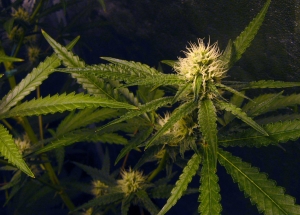The planet is warming and the pot is getting more potent.

That’s the upshot of what scientists are reporting, and officials are concerned this may lead to an increasing number of marijuana grown on public lands.
The report was recently issued by The Daily Climate, which highlights environmental health sciences news. Researchers say marijuana grown outdoors is probably going to become stronger and require less water to survive. That’s because over time, plants become adapted to reduced CO2 levels. As a result, they begin exhibiting more of their medicinal properties.
In other words, it becomes more potent, less edible.
To understand why, we have to understand the reason marijuana contains those psychotropic compounds like THC in the first place. Plants do not have the kinds of defense mechanisms animals do. They cannot get up and run away from a threat. So marijuana produces THC as a kind of pest and disease repellent. When a plant is under increased stress – disease, cold, head, etc. – the plant is going to produce more THC in order to ward off additional threats.
News of this increasing potency comes as there is an influx of cultivators and distributors throughout California. The California Department of Fish & Wildlife reported marijuana production has doubled in some areas of the state between 2009 and 2012.
With an increase in potency, there is a fear this will create incentive for an increasing number of people to seek out public lands on which to grow the drug. Trouble is, those who are already using public lands for this purpose are taxing the local ecosystems. This is going to be further exacerbated by the drought. It becomes increasingly cyclical problem.
A 2014 study by the CDFW indicated marijuana growers consumed 63,000 of gallons of water a day just in the so-called “Emerald Triangle.” These include Trinity, Humboldt and Mendocino Counties. So during any given growing season, that’s 9.5 million gallons for every growing season to irrigate some 10,500 outdoor marijuana plants.
That has meant an increase of land conversions, water diversions and fish die-off.
In addition to creating more potent pot, warmer climates also mean the drug can be grown at higher elevations. But again, this practice, sometimes referred to as “guerilla pot farming,” is done at great risk to the local ecosystem.
Farmers have been known to break from the traditional, established trails on public land and set up camps that are known to contain a fragile balance of plant and animal life. Once there, they divert streams and other water systems for irrigation. They then use large amounts of powerful and sometimes illegal pesticides.
In particular, scientists have been closely watching the effect on the salmon population in the northern California region because salmon are known to be essential to the maintenance and sustenance of a vast number of other species.
Just because an area grows increasingly hospitable to a certain species doesn’t mean it’s wise to make sure it flourishes there.
Aside from this, growers may face running afoul of federal and state law. Los Angeles marijuana lawyers know cultivation and distribution of marijuana is strictly regulated, and stepping outside those boundaries may result in severe criminal penalties.
The Los Angeles CANNABIS LAW Group represents growers, dispensaries, collectives, patients and those facing marijuana charges. Call us at 949-375-4734.
Additional Resources:
Climate Change, Drought Likely Means Marijuana Grown In California Will Be More Potent, May 13, 2015, CBS SF Bay Area
More Blog Entries:
LA Man Arrested for Alleged Medical Marijuana Dispensary Murder, May 2, 2015, Los Angeles Marijuana Lawyer Blog
